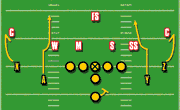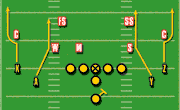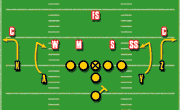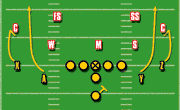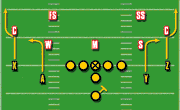AMERICAN FOOTBALL MONTHLY THE #1 RESOURCE FOR FOOTBALL COACHES
Article CategoriesAFM Magazine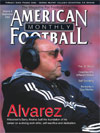
|
ATTACKING THE PERIMETER WITH THE QUICK GAMEby: Ted GilmoreWide Receivers Coach © More from this issue Why use the quick game? A big reason for this is our staff has always believed in the philosophy to take what the defense gives you. I know this is probably an overused cliché, but it is one that both our staff and quarterbacks believe in 100%. ADVANTAGES OF THE QUICK GAME • Protection - Don’t have to hold them out long. • Safe - High percentage completions, closer to the quarterback. • Wears on the D-Lineman - Cut, Cut, and Cut. • Horizontal/Vertical stretch on the defense. • Difficult to Disguise the blitz. • Creates Favorable “Match-ups”. • Quarterback doesn’t have to have a great arm. • Will make defense play tighter to WR, thus allowing us to throw over the top. • Structure rules to fit all formations-no tags in quick game. • Mirror all quick game. • Keep it simple learning. • Emphasize - Line up correctly and Push off the ball. • Give experienced quarterback green light to change route based on leverage and coverage.
Twins 90 vs Three Deep Zone. A/Y - Seam route, landmarks are 2 yards outside the hashmarks. Outside release and get vertical. If the flat defender buzzes to the flat, expect the ball. X/Z - Hitch route at six yards depth. Turn your inside shoulder toward the quarterback when you pivot. Do not drift back or toward the quarterback. Do not cut this route short, run a full six yards. Quarterback - Pick a side or game plan. 1. Read the cushion (Best Match Up) 2. Key flat defender - If flat defender intersects the hitch, throw the seam. If the flat defender gets depth, throw the hitch. 3. This is a three step drop/rhythm throw. Coaching Points: • Receivers must make this pattern look like four vertical. • Line up correctly and shove off the line of scrimmage.
Twins 90 vs Two Deep Zone. X/Z - Convert hitch route into a fade route. Whenever possible, outside release. If you must inside release, work back outside as fast as possible away from the half safeties. A/Y – Seam route, landmarks are two yards outside the hashmarks. Outside release and get vertical. Look for the football over the inside shoulder. Quarterback - pick a side or game plan. 1. Key the cornerback - if he sits and jams throw the fade between the half safeties and over the top of the squat corner. This throw must be on a line with very little air under it.(Best Match Up) 2. If the cornerback turns hips and runs with the vertical look to throw the fade. 3. If the half safety vacates the hash to get over the top of the fade route, throw the seam route. Coaching Point: • A/Y - Must release clean to hold the half safeties. You can not get re-routed. • Z/X - Step on the toes of the corner before you fade.
Twins 91 vs Three Deep Zone. Z/X - Runs a speed out at 5 yards rolling to 7 yards. We must always attack the defender outside leverage. A/Y - Hitch route at six yards depth. Turn your inside shoulder toward the quarterback when you pivot. Do not drift back or toward the quarterback. Do not cut this route short, run a full six yards. Quarterback - pick a side or game plan 1. Read the cushion(Best Match Up) 2. Key Flat Defender - If flat defender runs under out cut - throw the hitch. 3. This is a three step drop/rhythm throw. Coaching Points: • Alignments by the outside receiver must be tighter. • Shove off the ball and don’t chop you steps.
Twins 91 vs Two Deep Zone. Z and X - attack the outside leverage of the corner, if it’s a hard corner slam him and push up to your depth. A and Y - run a fade stem hitch at 6 yards depth. Turn your inside shoulder when you pivot to the quarterback. Do not drift back or toward the quarterback. Do not cut this route short, run the full six yards. Quarterback - pick a side or game plan 1. Read the cushion(Best Match Up). 2. Read the hook curl defender. 3. This is a three step drop/rhythm throw. Coaching Points: • Alignments by the outside receiver must have wide splits. • Inside receivers shove off the ball with a fade stem away from the hook curl defender.
Twins 92 vs Three Deep Zone. Z and X - runs a quick slant at 6 yards depth from the line of scrimmage. A and Y - runs an arrow route at 4 yards depth from the line of scrimmage. Quarterback - pick a side or game plan 1. Read the cushion(Best Match Up). 2. Read the flat defender- if he buzzes to the flat-throw the slant. If he gets depth take the arrow route. 3. This is a three step drop/rhythm throw. Coaching Points: • Outside receivers running the slants, make sure you keep it flat on the slants. • Inside receivers, if you’re in the boundary stutter your feet to give yourself time so that you don’t run out of room.
Twins 92 vs Two Deep Zone. Z and X - Attack the inside leverage of the corner on the 6 yard slant and expect the ball. A and Y - Run the arrow route expect the flat defenders to jump you. Once you reach the sideline turn it into a wheel route. Quarterback - pick a side or game plan. 1. Read the cushion(Best Match Up). 2. Read the flat defender- if the corner settles take the slant now. 3. This is a three step drop/rhythm throw. Coaching Points: • Outside receivers keep the slants thin vs Two Deep Zone, we want to split the corner and the safety. • Inside receivers get to your depth now, to hold the corners.
Twins 93 vs Three Deep Zone. Z and X - explode off the line of scrimmage as if your running fades, but hitch up at 6 yards of depth. Turn your inside shoulder toward the quarterback when you pivot. Do not drift back or toward the quarterback. Do not cut this route short, run a full six yards. A and Y - explode off the line of scrimmage directly at the defender over you. Close the cushion and release outside fading to the bottom of the numbers, looking over the inside shoulder for the ball. Quarterback - pick a side or game plan. 1. Read the corner - if he is soft take the Hitch route (Best Match Up). Coaching Points: • Outside receivers run the Hitch route with a fade stem- get width. • Inside receivers make sure your release is outside of the flat defender, so that it slows him down from getting to the flats.
Twins 93 vs Two Deep Zone. Z and X - explode off the line of scrimmage as if your running fades, but slam into the corner as you reach your depth to hold his attention. Turn your inside shoulder toward the quarterback when you pivot. Do not drift back or toward the quarterback. Do not cut this route short, run a full six yards. A and Y - explode off the line of scrimmage, running a fade to the bottom of the numbers looking for the ball over the inside shoulder. Quarterback - pick a side or game plan. 1. Read the Cushion(Best Match Up). 2. Read the corner if he settles on the Hitch- throw the fade to bottom to the numbers now. Coaching Points: • Outside receivers do a good job of pushing off the line of scrimmage, getting into the face of the corners. • Inside receivers fade to the bottom of the numbers now, do not worry about stepping on the toes of the near defender.
Twins 94 Vs Three Deep Zone. Z and X - explode off the line of scrimmage, attacking the inside leverage of the defender over the top of you. Push up to 4 yards of depth, opening up to the inside and continue across running an under route. A and Y - run a “Read Slant” on the near defender and shave his inside shoulder, turning him away from the under route. Quarterback - pick a side or game plan. 1. Read the cushion (Best Match Up). 2. This is a three step drop/rhythm throw. Coaching points: • Outside receivers take big splits-stretch the field. • Inside receivers regardless of the near defender drop, we must change our stem and shave his inside shoulder before we get vertical. Then look for the ball.
Twins 94 Vs Two Deep Zone. Z and X - explode off the line of scrimmage, attacking the inside leverage of the defender over the top of you. Push up to 4 yards of depth, opening up to the inside and continue across running an under route. A and Y - run a “Read Slant” on the near defender and shave the inside shoulder, turning him away from the under route. Quarterback - pick a side or game plan. 1. Read the cushion (Best Match Up). 2. Read slants second level. 3. This is a three step drop/rhythm throw. Coaching Points: • Outside receivers big splits-stretch the field. • Inside receivers regardless of the near defender drop, we must change our stem and shave the inside shoulder before we get vertical. Then look for the ball. 96 VS THREE DEEP ZONE Twins 96 Vs Three Deep Zone. Z and X - run a quick slant at 6 yards depth from the line of scrimmage. A and Y - run a “Read Slant” on the near defender and shave the inside shoulder, turning him away from the outside slant. Quarterback - pick a side or game plan. 1. Read the cushion (Best Match Up). 2. Read slants second level. 3. This is a three step drop/rhythm throw. Coaching Points: • Outside receivers big splits-stretch the field. Make sure you keep the slants flat. • Inside receivers regardless of the near defender drop, you must shave the inside shoulder before we get vertical. Then look for the ball.
Twins 96 Vs Two Deep Zone. Z and X - run a quick slant at 6 yards depth from the line of scrimmage. A and Y - run a “Read Slant” on the near defender and shave his inside shoulder, turning him away from the outside slant. Quarterback - pick a side or game plan. 1. Read the cushion (Best Match Up). 2. Read slant second level. 3. This is a three step drop/rhythm throw. Coaching Point: • Outside receiver big splits-make sure you split the corner and the safety on the slant. • Inside receiver regardless of the near defender drop, we must shave the inside shoulder before we get vertical. Then look for the ball.
Twins 97 Vs Three Deep Zone. Z and X - run fade routes, make sure we step on the toes of the defender, before we fade. A and Y - run speed outs at 5 yards of depth rolling to 7 yards. Quarterback - pick a side or game plan. 1. Read the cushion (Best Match Up). 2. Read the corner. 3. This is a three step drop/rhythm throw. Coaching Points: • Outside receiver’s big spilt- stretch the field and make sure shave the outside shoulder of the defender over you before you fade. • Inside receivers do a good job of shoving off the ball, pushing up to 5 yards rolling to 7 yards of depth.
Twins 97 Vs Two Deep Zone. Z and X - step on the toes of the corner before you run the fade route. A and Y - run speed outs at 5 yards rolling to 7 yards depth. Quarterback - pick a side or game plan. 1. Read the cushion (Best Match Up) 2. Read the corner-if he comes off on the speed out throw the fade. 3. This is a three-step drop/rhythm throw. Coaching points: • Outside receivers big split-stretch the field. Step on the toes of the corner and shave his outside shoulder before you fade. Once you clear him look for the ball. • Inside receivers do a good job of shoving off the ball, pushing up 5 yards rolling to 7 yards of depth. |
|
| HOME |
MAGAZINE |
SUBSCRIBE | ONLINE COLUMNISTS | COACHING VIDEOS |
Copyright 2024, AmericanFootballMonthly.com
All Rights Reserved


